|
|||||||||||
XI'AN - Hongjiannao, China's largest desert lake, is still shrinking as a result of climate change and human activities, and it could vanish in just a decade.
The lake, sandwiched between the Muus Desert in Shaanxi province and the Erdos Plateau in North China's Inner Mongolia autonomous region, has shrunk by over 40 percent in the past 15 years.
Its lake area measured 7,000 hectares in 1996, but has shrunk to 4,000 hectares, and its water level is declining by 60 centimeters annually, data from the lake's management committee showed.
"Unless adequate measures are taken, Hongjiannao may vanish in just 10 years," said Ren Leijie, director of the general office of the committee.
Experts fear that Hongjiannao may become another Lop Nur, which, located in Xinjiang Uygur autonomous region, was the largest lake in northwestern China before it dried up in 1972 due to desertification and environmental degradation.
Dams have been built since 2006 on two of the seven rivers that drained into Hongjiannao to improve water conservation facilities in the upper stream, which has cut off water supplies to the lake, said Li Wenyi, an official with the management committee.
About 40 percent of lake's water came from the Yingpan River before a dam was built on the river five years ago.
Meanwhile, Hongjiannao has gradually lost the water that it used to get from underground streams and rivers as excessive coal mining around the lake has changed the way water flows underground.
The area has seen less rainfall in recent years, which also contributed to the shrinking of the lake.
Fish have nearly vanished from the lake that had once been a major fish production base in Shanxi province, said Li Weiping, head of the provincial fish monitoring station.
As the lake continues to shrink, the water has become more salty and its pH reading has reached 9.6, while the maximum reading suitable for fish is 8.5, according to Li.
"Our fishery used to produce more than 300 tonnes of fish a year at peak times, but now fish can no longer survive in Hongjiannao and we have to drill wells for fresh water to raise fish," said Ma Maocai, who has been working for a fishery at the lake for nearly 50 years.
As the lake dries up, over 30 wild birds, many of which are rare species under state protection, will have to find other places to live.
Hongjiannao may lose its "Hometown of Relic Gulls" title. The lake is home to over 8,000 relic gulls - 90 percent of the endangered species' world population.
Besides the shortage of water supplies, Hongjiannao has also been affected by industrial pollution from coal-fired power plants and coal mines, with the nearest less than 3 kilometers from the lake.
Experts have urged the government to set up a national level nature reserve in the area to better protect the lake and nearby wetlands, or, like Lop Nur, they will regret its disappearance.
Hot Topics
HIV/AIDS, Egypt protest, Thanksgiving, climate change, global economic recovery, home prices, high-speed railways, school bus safety, Libya situation, Weekly photos
Editor's Picks

|

|

|

|

|

|







